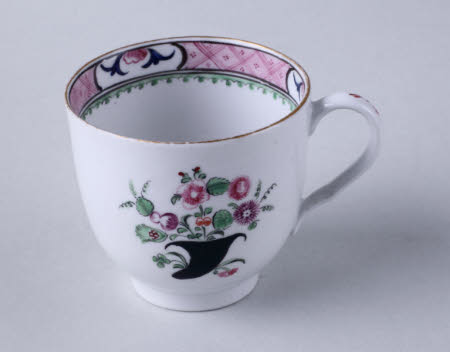Coffee cup
Anthony Keeling & Sons
Category
Ceramics
Date
1790 - 1800
Materials
Hybrid hard paste porcelain with overglaze enamels
Measurements
65 mm (Height); 70 mm (Diameter)
Place of origin
Stoke-on-Trent
Order this imageCollection
Hill Top, Cumbria
NT 641433
Summary
Coffee cup, hybrid hard paste porcelain, Anthony Keeling & Sons or Anthony & Enoch Keeling, Tunstall, Stoke-on-Trent, ca 1790-1800, with low foot rim, rounded body and simple loop handle; decorated in enamel colours with flowers in black vase at front a border inside the rim of pink crosshatching pattern broken by pink flowers and leaves in reserves, with dentil border below. A label to the underside of the cup: '1902/This cup was lent to me for the Tailor. bought at Mrs. Wright's sale August 1936'.
Full description
This cup is part of the collection at Hill Top. Beatrix Potter purchased this farmhouse in the Lake District village of Near Sawrey in 1905, using the profits from her books. After her marriage to William Heelis in 1913, Beatrix relocated permanently to Sawrey. The couple made nearby Castle Cottage their home, but Beatrix spent as much time as she could at Hill Top. As well as a space for work and creativity – and the location for many of her famous tales – it became an intensely personal sanctuary for her. Beatrix knew exactly how she would decorate Hill Top and she arranged its interiors carefully and deliberately. She wrote: ‘I would have old furniture…it is not as expensive as modern furniture, and incomparably handsomer…’ Once she had renovated the farmhouse, she filled it with examples of local furniture and treasured heirlooms, like her grandmother’s warming pan and a set of plates decorated with designs by her father. A number of ceramics from Hill Top are recognisable in Beatrix’s artworks – and a few were used in illustrations for her Tales. Of her books, The Tailor of Gloucester was one of Beatrix’s favourites. She published it privately in 1902 and it was released by her publisher the following year. Beatrix was staying in Stroud with her cousin, Caroline Hutton, when the story that formed the basis of The Tailor was recounted to her and she decided to develop it into her own tale. She travelled into Gloucester, sketching in the streets and around the cathedral. She was allowed to make sketches in a few cottages, capturing details of their interiors, including a dresser filled with brightly coloured ceramics. Beatrix also visited a tailor’s shop in Chelsea and the Victoria and Albert Museum, where she sketched the beautiful eighteenth century waistcoat that features in the story (V&A 652A-1898). Writing in 1910 to Mrs Elizabeth Hadfield (an admirer in New Zealand) about The Tailor, Beatrix recalled that ‘the china was borrowed from the cobbler’s wife at Sawrey, it had been in her mother’s family, some of it was very old…they were not marked but looked like Bristol china.’ A brown label stuck to the underneath of the cup, written in Beatrix’s handwriting, tells us more. It reads: '1902 / This cup was lent to me for the Tailor, bought at Mrs. Wright's sale August 1936'. When sorting through her possessions at Hill Top, Beatrix attached notes like this to the backs of pictures, slipped them into books or other things that had a special interest. The cup is shown in an illustration in Beatrix’s 1902 hand-written manuscript for The Tailor (NT NT242204). In the scene, the mice are standing on the dresser, peering through the cups hanging above them towards Simpkin the cat, who stands below. From here, they listen to the tailor describing the coat he needs to finish for the Mayor. A note below reads: ‘This is out at present. Seems a pity. To be drawn again, tailor instead of cats.’ This cup is probably also illustrated in the published image that accompanies the same part of the story (The Mice Listen to the Tailors’ Lament, 1902, Tate, A01098). It frames the right edge of the scene in which the mice stand on the dresser, watching the tailor as he worries about the unfinished coat. While not an exact copy of the cup, they share a distinct similarity in terms of the shape, decoration and colour. A dish from the collection at Hill Top is also illustrated in the left side of the image (NT641561).
Provenance
'1902. This cup was lent to me for the Tailor. bought at Mrs. Wright's sale August 1936'. (label)
Marks and inscriptions
1902/This cup was lent to me for the Tailor. bought at Mrs. Wright's sale August 1936. (label, underside of cup base)
Makers and roles
Anthony Keeling & Sons, manufacturer
References
Conroy 2023: Rachel Conroy, ‘A love of ‘old china, especially earthenware’: ceramics at Beatrix Potter’s Hill Top and in her ‘little books’, Transactions of the English Ceramic Circle (Volume 34, 2023), 95-112

